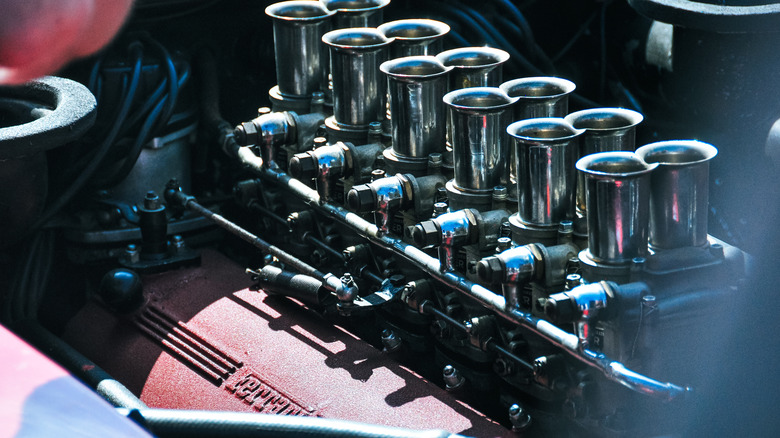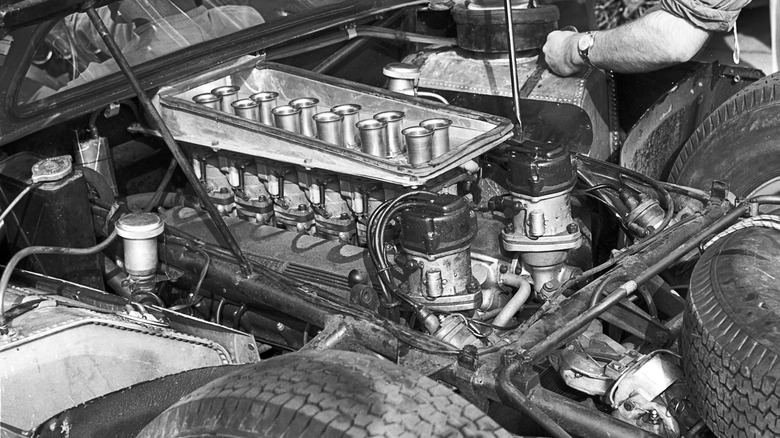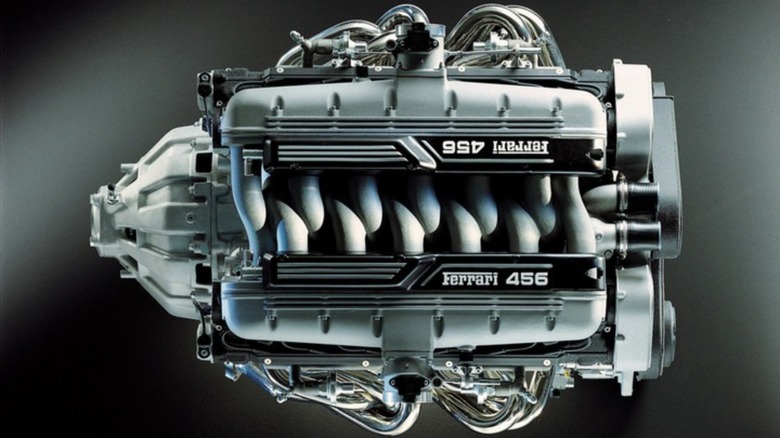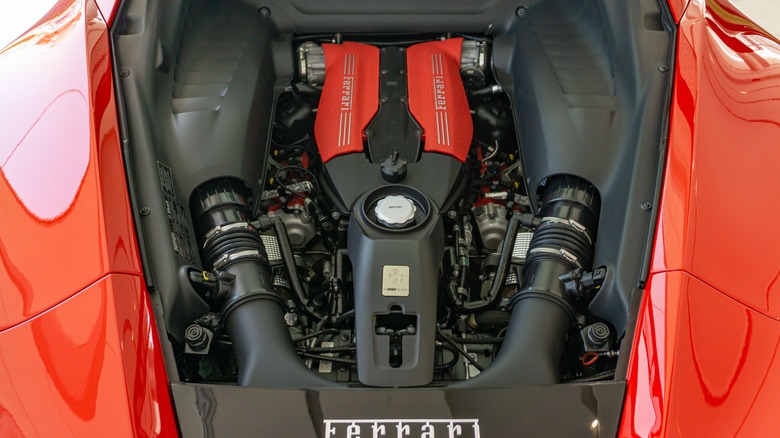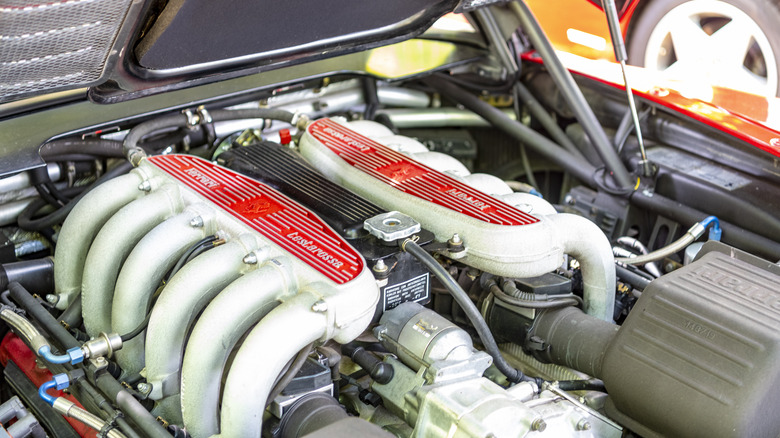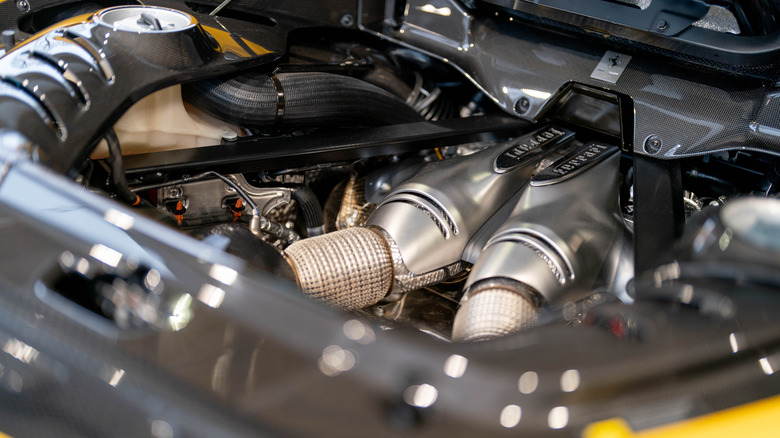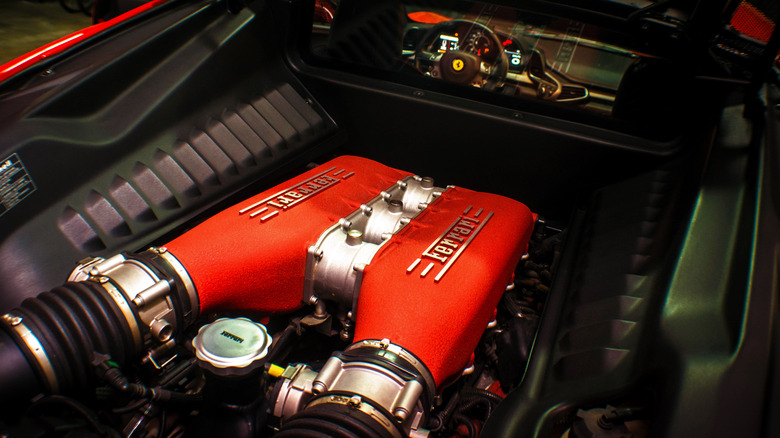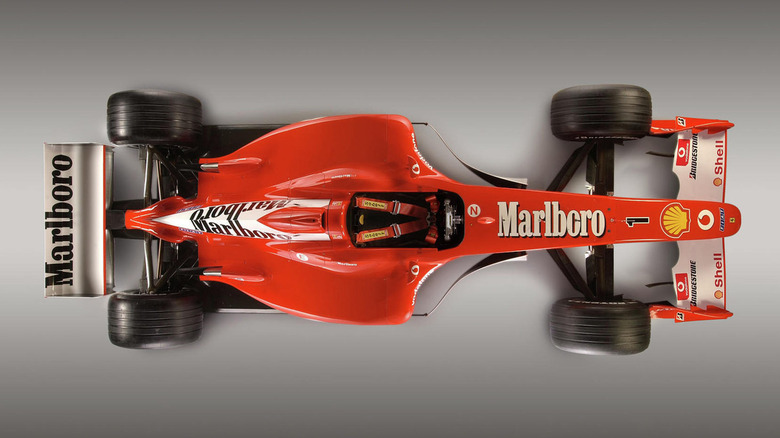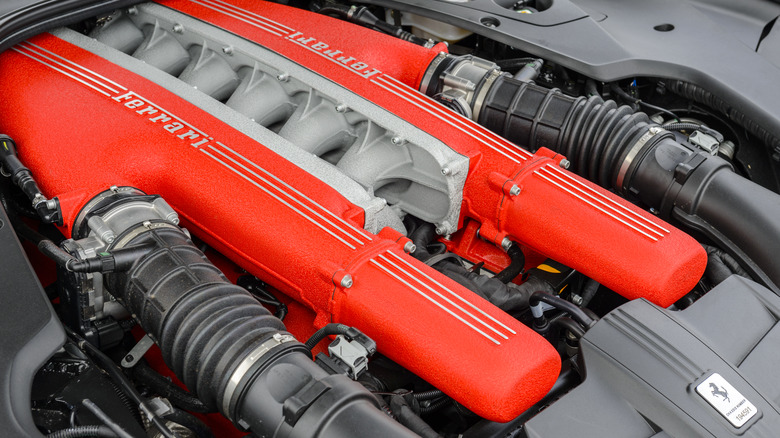8 Best Engines Ever Put In A Ferrari
There are numerous factors that make Ferrari arguably the greatest name in the car world — its stunning designs, its exclusivity, and its storied racing history. However, Ferrari's biggest strength has always been its ability to create world-leading engines, with the perfect balance of race-winning performance and a crowd-pleasing soundtrack. The brand is most famous for its 12-cylinder engines, but its V8 and V6 powerplants have also proved to be among the best of their kind over the years.
However, times are changing over in Maranello. Much like the rest of the industry, Ferrari has begun the inevitable switch toward electrification, with the brand's latest supercars receiving hybrid powerplants and an electric supercar set to be unveiled in 2025. Ferrari's CEO has confirmed that he expects 40% of the carmaker's sales to be pure electric by 2030, with 80% electrified to some degree. The days of Ferrari's internal combustion engines are numbered, then, but the brand's legacy of world-beating gas powerplants won't be easily forgotten. These eight represent the best of the Prancing Horse's past and present output.
Ferrari Colombo V12
If there was one single engine that most enthusiasts would point to as the most important for Ferrari, it's the Colombo V12. The iconic powerplant was designed for the brand's first car in 1947, and it continued in various forms until the late '80s. It takes its name from its designer, Ferrari engineer Gioacchino Colombo, and in its original incarnation, it sported a relatively small 1.5-liter displacement. Colombo had previous experience designing race-winning V8s of the same displacement for Alfa Romeo, but the new V12 proved to be especially competitive and established Ferrari as a name to watch out for.
Its most famous application was in the 250 line of race cars, the rarest of which are among the most expensive Ferraris to buy today. Over the decades, the Colombo V12's displacement grew, reaching 4.0 liters by the time the 330 series was launched in 1963. It remained in production for another couple of decades after that, eventually powering the 400 and 412i before bowing out when the latter car was retired in 1989. It was later replaced by an all-new V12 design, but its legacy lives on as one of the greatest 12-cylinder engines in automotive history.
Ferrari F116/F133
Originally debuting in the 456 GT, the F116B was the first all-new 12-cylinder Ferrari engine design since the "Boxer" engine of the '70s, and it effectively replaced the Colombo V12's place in the lineup, powering the brand's grand tourers. It sported a new 65-degree angle between the cylinder banks, as opposed to the 60-degree angle that had been a signature of the Colombo engine. Later versions of the 456 used the reference F116C, but both designations produced 442 horsepower in 456, with peak power arriving at 6,200 revolutions per minute.
It was later used in the 550 Maranello, with minor revisions and the factory reference F133A. These revisions boosted power output to 478 horsepower, which was delivered at 7,000 revolutions per minute. A further revised version appeared in the 575 Maranello, with the engine's final appearance being in the 612 Scaglietti, where it made 533 horsepower. Ferrari's reputation for making grand tourers had somewhat waned with the 412i, but thanks to this new V12, its successors reaffirmed the brand's place at the top of the tree, blending all-out performance with smooth power delivery.
Ferrari F154
Ferrari's 12-cylinder engines might steal the limelight, but the brand's line of V8 engines are just as class-leading, with the F154 standing out in particular. The 3.9-liter twin-turbo V8 debuted in the California T, making 552 ponies and 557 pound-feet of torque. It's appeared in every eight-cylinder Ferrari since, including the 488 GTB, F8 Tributo, and even with electric assistance in the SF90 Stradale, where it makes 769 horsepower.
Its combination of high-revving performance and visceral soundtrack impressed industry experts at the International Engine of the Year Awards so much that they awarded it the title of "Best Engine of the Past 20 Years" in 2018. That puts it up against some very stiff competition, with everyone from Koenigsegg to BMW having a legitimate claim to the title, but it was the Prancing Horse that ultimately impressed the judges. It's not just humans that approve of the F154's capabilities, either: We asked ChatGPT to name the five best engines ever, and Ferrari's latest V8 was one of its picks. So the verdict is in: It's expert-approved, AI-approved, and undoubtedly enthusiast approved too.
Ferrari F113
Depending on who you ask, the F113 is either Ferrari's greatest flat-12 engine or one of its greatest V12 engines. The confusion stems from the discrepancy between its layout and the official terms that Ferrari uses to describe it. Technically speaking, the engine is laid out like a 180-degree V12, with opposing pistons connected to one crank pin, rather than one crank pin per piston as with a typical "flat" boxer engine. The F113 is therefore definitely not a boxer — however, some would argue that any 12-cylinder engine laid out at a 180-degree angle could be classified as a "flat-12," and Ferrari confused things even further by referring to cars with the flat-12 design as "BB" — an abbreviation of "Berlinetta Boxer."
Ferrari later claimed that the "Boxer" designation was simply "poetic license" to cover up the fact that the car where it first appeared, the 365 GT4 BB, was unofficially named after movie star Brigitte Bardot during development and that the original name would have been too scandalous to add to a production vehicle. Whatever you want to call it, the 180-degree 12-cylinder engine was one of the most iconic powerplants of its era, with the F113 engines found in the Testarossa and F512M being the peak of over 20 years of its development. In its most powerful configuration in the F512M, the engine produced 440 horsepower at 6,750 revolutions per minute.
Ferrari F163
The Ferrari F163 V6 engine debuted in the 2022 296 GTB, and it boasts a slew of firsts. It's the first V6 engine in a road-going Ferrari (excluding Ferrari's sub-brand Dino), and it holds the title of the world's highest specific output engine. It produces 654 horsepower from 2,992cc of displacement, the highest horsepower-per-liter ratio of any production car. It's also uniquely designed — the engine's cylinder banks sit 120 degrees apart, giving it a lower center of gravity than a traditionally shaped V6.
The turbochargers sit inside the vee of the engine, with the more efficient design saving weight overall. This also contributes to the engine's unique soundtrack — with less complicated piping than other six-cylinder engines, the exhaust note sounds closer to that of Ferrari's V12 engines than a traditional V6. In the 296 GTB, the engine is complemented by an electric motor, giving the car an all-electric range of around 16 miles. That means it can comply with urban restrictions around emissions and noise levels while maintaining its distinctive howl when it gets out of town. Hybrid performance cars are an inevitable compromise as the industry moves towards electrification, but the F163 V6 proves those compromises don't have to mean sacrificing the traditional Ferrari soundtrack, at least not yet.
Ferrari F136
Most Ferrari-developed engines end up in cars with the Prancing Horse badge, but not all. The F136 V8 was developed as a joint project for both Ferrari and Maserati, and it made its debut in the Maserati Coupe and Spyder back in 2001. It later featured in a variety of Ferrari models, including the F430, California, and 458. It even made its way into the Alfa Romeo 8C Competizione, making 444 horsepower in the limited-run supercar.
Notably, the F136 is the last naturally-aspirated Ferrari V8, with its successor the F154 sporting twin turbos. Although the engine was phased out in Ferraris after the 458, it lived on in the Maserati GranTurismo and GranCabrio until 2019. Apart from its performance, the F136 was renowned for its soundtrack, which as any owner of an older Ferrari will be keen to point out, always sounds better when there are no turbos involved.
Ferrari 053
Michael Schumacher's domination of the 2004 Formula 1 season was absolute, with the German racking up 13 wins in 18 races to comfortably clinch both the drivers' and manufacturers' titles. As exceptional a driver as he was, he wouldn't have been able to pull off such an incredible feat without a suitably exceptional car, at the heart of which sat Ferrari's 053 engine. New regulations for the 2004 season demanded that only one engine should be used for an entire race weekend, and so the team's 3.0-liter V10 was reworked with tougher parts and an optimized design to ensure it could go the distance.
Feeding the engine was a new fuel developed in partnership with Shell, alongside a new engine oil. An official horsepower figure was not disclosed, with Ferrari cryptically stating it produced "enough" to outshine its competitors. Its V10 predecessors from the previous seasons had already taken Schumacher to victory in the championship, but none quite so convincingly as the 053. The F2004, with Schumacher at the wheel, became one of the most successful F1 cars of all time. The V10's time in the limelight was short-lived, however, as Ferrari switched to V8 power for the 2006 season.
Ferrari F140
While the death of the V12 engine is almost inevitable as gas-powered cars get phased out thanks to impending zero-emissions regulations, the Ferrari F140 proves that there's still plenty of room for a 12-cylinder car in the market for now. The F140 debuted in the Enzo, with its design based on that of the F136 V8 engine. The 6.0-liter V12 in the Enzo was the most powerful naturally-aspirated engine fitted to a production car at the time of its release, and it was carried over to the Maserati MC12, with which the Enzo shares its underpinnings.
Since then, versions of the engine have appeared in the LaFerrari, 812 Superfast, and F12 Berlinetta, as well as a number of low-volume specials. It was recently confirmed that the Purosangue SUV will also feature a reworked version of the same engine, and with long waiting lists already reported for the model, it seems new V12 Ferraris will continue to be produced at Maranello for the foreseeable future.
